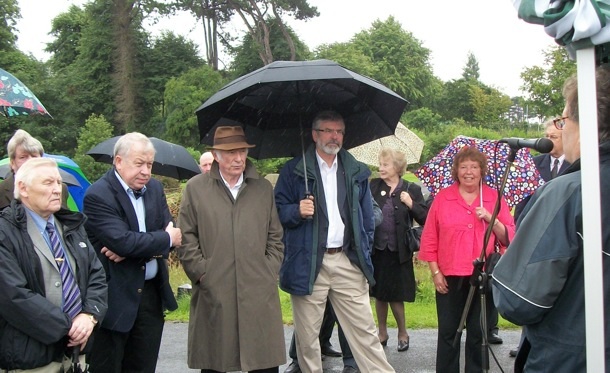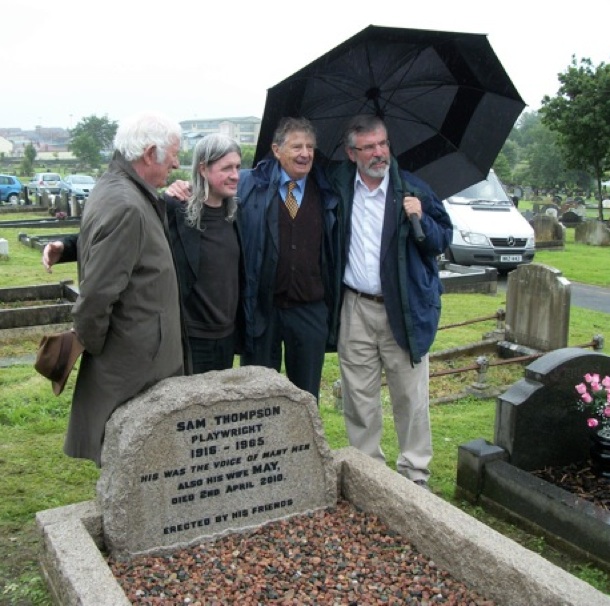2 September 2013
Seamus Heaney – Gerry Adams remembers a national treasure

⚫ Seamus Heaney and Gerry Adams listening to Tom Hartley at the rededication ceremony at Sam Thompson's grave
When I was writing ‘Hope and History’, which deals with the 1980s and 1990s and the birth and evolution of the Peace Process, I contacted Seamus and asked if he minded me quoting from his poem ‘The Cure at Troy’
SEAMUS HEANEY is dead. When I heard the news I was cleaning out a shed. Dirty and dusty and lost in that chore, I got the news by text. I was deeply shocked. I stood for a while trying to take it in. I still can’t quite believe it.
Although I have known Seamus personally for many years, like millions of others I first knew him through his words – and what words. As a result I seem to have known him most of my life. And now he’s gone.
Seamus was a national treasure. He was of us with a profound and humane understanding of us as an island people with all our fault lines and flaws and strengths. He was extremely modest, approachable and humble. And, until his death, the world’s greatest living poet in the English language.
His name is spoken of in awe alongside those of Yeats, Joyce and Friel, O’Connor and Kavanagh, and O’Brien, O’Casey and Shaw and so many of our other great writers and poets.
He was a proud Tamlaghduff man from County Derry who loved his place and people. And he wrote about them often. In his first major collection – Digging – he wrote of his father digging for potatoes and his grandfather cutting the turf:
By God, the old man could handle a spade.
Just like his old man.
My grandfather cut more turf in a day
Than any other man on Toner’s bog.
Once I carried him milk in a bottle
Corked sloppily with paper. He straightened up
To drink it, than fell to right away
Nicking and slicing neatly, heaving sods
Over his shoulder, going down and down
For the good turf. Digging.
He and Michael McLaverty both taught for a time in St Thomas’s Secondary School on the Whiterock Road in west Belfast.
I first read Seamus Heaney in the early 1970s. They were difficult and dangerous years. West Belfast, like other places, was under British Army military occupation. Once, while travelling on a bus down the Falls Road I was so busy reading his Death of a Naturalist, that he had published in 1966, that I failed to notice that the Brits had stopped the bus. It was the Parachute Regiment and they walked menacingly up and down, asking passengers their names, addresses where they were going, and checking this info with their Intelligence Officer and against cards of photos they carried with them of those they were hunting.
One Brit stared at me for a second and then questioned the passenger behind me. Everybody heaved a sigh of relief when they got off. From that point on, Seamus Heaney became a sort of talisman for me.
In 2003, when I was writing Hope and History, which deals with the 1980s and 1990s and the birth and evolution of the Peace Process, I contacted Seamus and asked if he minded me quoting from his poem The Cure at Troy. It seemed to me then and today that The Cure at Troy at once catches the despair of conflict and the hope of peace and justice. And “hope and history rhyme”. He generously agreed.
More recently, in 2010, he returned to west Belfast for the rededication of a stone at the grave of playwright Sam Thompson and to speak about Michael McLaverty at a Féile an Phobail event in St Mary’s University College on the Falls Road. Sam Thompson was a well-known and influential writer. In 1959, the directors of the Group Theatre in Belfast refused to stage Over the Bridge because of the way it highlighted sectarianism. The well-known actor Jimmy Ellis left the group to set up his own company and went ahead with the play in 1960.
Seamus and other contemporaries of Sam Thompson’s (including Sam’s son Warren and Jimmy Ellis) gathered with the rest of us in the City Cemetery in the mizzley soft rain for a poignant little event. Although it is a story that will be told at another time the ceremony was hilarious and indeed ended up with Seamus giving the tribute to both Sam Thompson and Jimmy Ellis.
Afterwards, Seamus and Marie Heaney went off with Danny Morrison to visit St Thomas’s School where Seamus and Michael McLaverty used to teach It was his first time there since 1961. By all accounts, it was a very emotional visit for him. Incidentally, in his poem Whatever You Say, Say Nothing, he uses the line “Is there a life before death.” That legend first appeared in neat white capitals on the wall of the City Cemetery on the Whiterock Road. I saw it the first morning after it was painted.
His talk in the big hall in St Mary’s where he told us of the first time he saw his wife Marie were also emotional moments for this wonderful poet and thoroughly decent man. His tribute to McLaverty, because that is what it was, was peppered with humorous little insights and telling observations. We all sat enthralled. And then he read us some of his poetry. In many ways this visit was also a reconciliation. I think Marie understood that and she was delighted.
As well as being a wonderful human being, Seamus was a literary figure of huge international stature, regarded by many as the greatest Irish poet since Yeats. In 1995, he was awarded the Nobel Prize for Literature. The Nobel citation described his poetry as “works of lyrical beauty and ethical depth, which exalt everyday miracles and the living past”.
Seamus was wise and modest and dazzled us constantly with his wordsmithery. His poetry uplifted and surprised us; challenged and brought comfort. He was in Derry during the Fleadh with Liam Óg Ó Flynn performing The Poet and the Piper. His verse The Given Note involves two of my favourite pieces – Port na bPúcaí, played by Liam, and Seamus’s own The Given Note. I’m going to play the CD now.
Seamus knew his gift was a given but he worked at it. Magically weaving words, reliving memories, invoking imagination and emotion. Making us laugh and cry. And also making us think.
My thoughts at this time are with Seamus’s wife Marie and his family.
But no celebration of his life would be complete without reference to The Cure at Troy and his deep sense of hope for the future that underpins it.
Human beings suffer,
they torture one another,
they get hurt and get hard.
No poem or play or song
can fully right a wrong
inflicted or endured.
The innocent in gaols
beat on their bars together.
A hunger-striker's father
stands in the graveyard dumb.
The police widow in veils
faints at the funeral home.
History says, Don’t hope
on this side of the grave.
But then, once in a lifetime
the longed for tidal wave
of justice can rise up,
and hope and history rhyme.
So hope for a great sea-change
on the far side of revenge.
Believe that a further shore
is reachable from here.
Believe in miracles
and cures and healing wells.
⚫ Below: Seamus Heaney, Warren Thompson, Jimmy Ellis and Gerry Adams at the rededication of Sam Thompson's grave

Follow us on Facebook
An Phoblacht on Twitter
Uncomfortable Conversations

An initiative for dialogue
for reconciliation
— — — — — — —
Contributions from key figures in the churches, academia and wider civic society as well as senior republican figures





